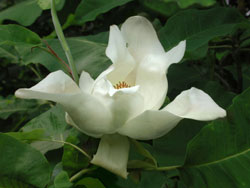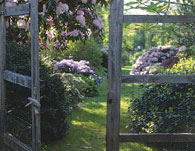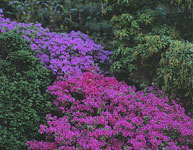Room to Grow: Polly Hill '28
Travel to Martha’s Vineyard to meander through the quaint former whaling port of Edgartown, eat fresh lobsters on the beach at Menemsha, or ride the waves at Chappaquiddick. But whatever you do, don’t miss a visit to the Polly Hill Arboretum in West Tisbury. Most visitors to the arboretum enter via the visitors’ parking lot (nestled among native Vineyard oaks and beeches) and start their tour at the beautifully designed welcome center. Energetic and knowledgeable volunteers can offer you an informative and enjoyable walk through the grounds. But to really appreciate the arboretum is to have Mary Louisa (Polly) Butcher Hill ’28 herself as your tour guide.
Barnard’s Inn Farm
Maneuvering a yellow electric golf cart around the grounds, 95-year-old Polly begins the tour. “Where we lived outside of Philadelphia, it was very wooded. Mother loved the open air and the open fields [of the Vineyard]; that’s what inspired her to pick this spot.” While Polly and her sister Dora Butcher Hillman ’28 were sophomores at Vassar, her parents purchased the abandoned sheep farm they later named Barnard’s Inn Farm. Later in 1935, Polly’s mother evicted the animals and modernized the Cow Barn into what is now Polly’s home on the island. But over the years, as buildings and structures were restored, the surrounding 40 acres of fields were left unchanged. That is, until Polly took over the land 22 years later.
Polly’s fascination with horticulture stemmed from frequent visits to the renowned gardens of Winterthur and Longwood Gardens near her home in Delaware. “I started to volunteer there, took courses, but mostly I just hung around and made a pain of myself,” Polly recalled. So, armed with years of observation and her admitted Vassar-instilled curiosity, Polly started experimenting with her own land.
Dogwood Allee
Just down from the Cow Barn is the Dogwood Allee, a double row of 30 Cornus kousa, flowering dogwood trees native to eastern Asia. When Polly took over the land in 1957, it was merely neglected fields and stone walls. In keeping with the New England, and especially Vineyard, style of open landscaping, one of Polly’s first projects was to establish this lane. From the entrance of the allée one has an unobstructed vista past the Cow Barn all the way to the North Field. “I like the open feeling it provides,” said Polly.
Julian Hill Magnolia

Nursery
Passing through a low stone wall, another feature of New England landscaping that Polly has honored, she steers her cart toward the nursery. It is in this open-air plot of land where Polly has grown most of the plant introductions to the arboretum from seed. Through a process of careful observation, Polly selects the heartiest of seedlings to plant in the arboretum. “You plant a row of [seeds] and pick out the best. I learned that the hard way. When people came to see me, I would ask, ‘Don’t you want one? I have more than I need.’ But then they would always pick the best. So I learned to stop myself and say, ‘Wait a minute, save those for this place,’” said Polly. She is also quick to add that she grows from seed because “it’s cheaper and you can get them sent to you from anywhere in the world.”
Polly’s Playpen
After passing through the Pleached Hornbeam Arbor — a dense canopied path that shelters the property from the sights and sounds of the adjacent road, in addition to successfully hiding her nursery from prying eyes and sticky fingers — the tour leads

But not all of Polly’s experiments were successful — her dead file is larger than her living file. One year her attempts to develop a hardy camellia resulted in more than 50 plants being taken to the dump. And yet another year, she planted what she thought was a pine seed. “It started to grow and I thought it was a funny looking pine,” recalled Polly. And although she doesn’t care for spruce trees, she “got one without trying to.” The pine seed grew into a 70-foot spectacular blue spruce.
This process of trial and error is all part of Polly’s plan. “You never know what [plants] are going to do. You can read, you can wonder, or you can try.” It is in the willingness to try, and oftentimes fail, that Polly ultimately succeeds. Polly freely admits that the arboretum has not been a one-woman job, but instead a collaboration with growers such as Dr. Rokojo as well as the opinions, ideas, advice, and manual labor of her friends, family, and fellow plant lovers that makes the arboretum is what it is today — a veritable island treasure.
Polly Hill’s Legacy


As the arboretum celebrates its fifth year, local residents, vacationers, students, and naturalists continue to enjoy the grounds, listen to lectures, and learn about botany. Upholding the arboretum’s mission to “disseminate the knowledge of plants and scientific procedures through educational programs, research, and exploration,” Melinda DeFeo, the arboretum’s current education coordinator, works with the school groups that visit. Students and teachers spend time observing plants, collecting fruits and seeds, and discussing the Vineyard’s native people and plants. Usually on these visits the students get to meet Polly. She will regale them with stories of when and how a particular tree was planted, and the children can see the results for themselves. “This is always a special time because the kids know that Polly has seen things from the beginning,” said DeFeo.
Whether or not you are lucky enough to tour the grounds with Polly as your guide, any time is a good time to visit the arboretum, for as Polly said, “There is always something in bloom.”
Vassar College Arboretum
Vassar's own arboretum also takes pride it its diverse group of over 200 species of trees. However, unlike the Polly Hill Arboretum, the campus attempts to blend distinctive landscaping with grand architecture. "Vassar's landscape plan is to liberate buildings from the landscape," said Director Grounds Jeffrey Horst. "The goal is to keep plants and trees away from buildings to frame and highlight a building rather than hide it."
When Horst first came to Vassar in 1990, he started "reclaiming the lost landscape," he said. "At the time, the campus was overrun with honeysuckle. By eliminating the competition, the diverse plants beneath could establish a foothold in the landscape." At first his methods seemed extreme. In a Miscellany News written shortly after Horst came to Vassar, he was dubbed the "Landscape Destroyer." But after more than 10 years, the fruits of his labor are apparent. And planning for the future continues. On the land below the Center for Drama and Film and the new Terrace Apartments, Horst and his crew are starting to establish the "next-generation forest."
